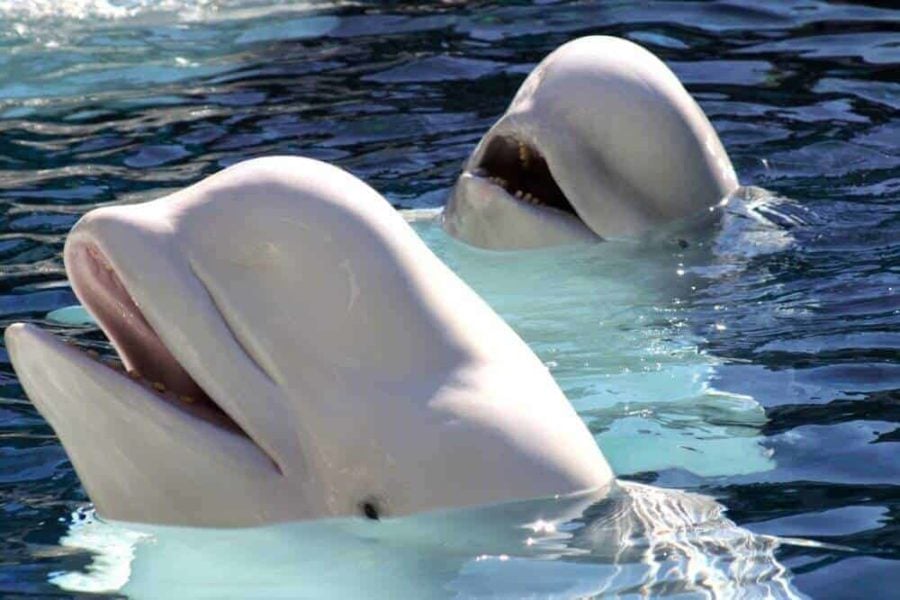At Mystic Aquarium, a researcher holds a small drum-like object over the blow hole of a beluga whale. The little drum is actually a petri dish wrapped in nylon mesh. On command, the whale exhales and tiny droplets of moisture from the animal’s breath are gathered on the mesh.
This curious interaction is part of a new collaboration between Mystic Aquarium and UConn, where researcher Tracy Romano and her team are developing new methods to test and study the physiology of marine life, with the goal of improving conservation efforts.
In assessing an animal’s overall health and physiological state, the goals is to collect samples in a manner that is minimally invasive and to draw data from as few samples as possible, to avoid causing the animal distress that could obscure the results. This is where the inhabitants of Mystic Aquarium come in.
“The samples taken from beluga whales and other animals at the aquarium will serve as a baseline for comparison to animals in the wild,” says Romano, associate professor-in-residence of marine sciences at UConn. “These animals are in a controlled environment, and many are trained to give samples on cue. We want to learn as much as we can about the animals in our care.”
On the opposite end of the distress spectrum, samples are also gathered from animals that are in the aquarium’s stranding rehabilitation program, which has been called to respond to more than 1,000 instances of stranded or beached animals.
“Stranding is perhaps the most stressful situation for these animals to be in,” Romano says. “We are able to sample those animals throughout their rehabilitation, all the way until they are released.”
This spectrum of samples from known stressed or non-stressed states can then be referenced by the researchers when they gather samples from animals in the wild. Although the work is largely with beluga whales, the team is also looking at animals such as turtles, penguins, sea lions, and other whales.
“We don’t know what animals have been exposed to in the wild,” says Romano, “but all of the [data we collect] will help in the creation of that baseline for comparison.”
Samples collected from animals in the wild and from those at the aquarium are analyzed in the lab at UConn Avery Point, where the team is using a variety of molecular techniques to glean information about the animals. Samples may include a skin biopsy, feces, saliva, and feathers. Molecular analysis of these tissues yields overall health and physiological clues, such as reproductive and stress hormones and immune factors, that enable the researchers to get an idea of the types of illnesses animals have been exposed to, how well their organs are functioning, and even the progress of pregnancies.
“A lot of work has gone into developing this health assessment ‘tool box’,” Romano says.
As the data is consolidated, researchers can get an idea of the overall health of a population of animals, and can deduce trends. A key goal of this work is to better understand the effects humans and the changing climate are having on marine wildlife.
One of the team’s major projects is with different populations of beluga whales in Alaska. The beluga population in Bristol Bay is being used as a control group to study another group of belugas, an endangered group in an area called Cook Inlet, near Anchorage.
“Everyone is very familiar with the many pressures the Arctic is under,” says Romano, however, “no one is quite sure why [the Cook Inlet] population is declining and isn’t recovering.”
The researchers hope to help piece together the puzzle. They are working with a local Eskimo tribe called the Inupiat near Point Lay Alaska, where the local people assist the team in collecting samples from marine wildlife. The information is recorded in a database that will provide a baseline for marine species in the Arctic, even as drilling for oil increases in the region.
Romano points out that there is no such baseline for areas such as the Gulf of Mexico, “but if an oil spill happens in the Arctic we will have this data.”
And on a broader level, the researchers hope that the data will help clarify the true impact human and climate are having on the health of the world’s oceans, and that the knowledge gained will be used in conservation and management efforts worldwide.
If our reporting has informed or inspired you, please consider making a donation. Every contribution, no matter the size, empowers us to continue delivering accurate, engaging, and trustworthy science and medical news. Independent journalism requires time, effort, and resources—your support ensures we can keep uncovering the stories that matter most to you.
Join us in making knowledge accessible and impactful. Thank you for standing with us!

